I. Introduction
What is Creativity?
Creativity is the ability to transcend traditional ideas, rules, patterns, relationships, or the like, to create meaningful new ideas, forms, methods, or interpretations. It is not confined to artistic endeavors alone—it permeates every aspect of life, from everyday problem-solving to professional innovation.
In the personal realm, creativity can boost mental well-being by providing an outlet for expression and stress relief. Professionally, it drives innovation, efficiency, and competitive advantage. Creativity can manifest in various forms, including artistic creativity (painting, writing, music), problem-solving creativity (engineering, mathematics, science), and social creativity (business strategies, community projects).
Introducing Divijos
Enter Divijos—a comprehensive framework designed to foster and enhance creativity across different domains. Divijos is not just a set of steps; it’s a philosophy that encourages a holistic approach to thinking and creating.
The Divijos framework outlines a systematic approach to creativity, breaking down the process into manageable elements that anyone can follow. By applying the principles of Divijos, you can unlock new levels of creative potential, whether you’re solving complex problems at work, embarking on a new artistic project, or brainstorming innovative marketing campaigns.
This guide is designed for individuals of all ages who seek to boost their creative abilities. Whether you’re a student, a professional, or a retiree looking to explore new hobbies, the Divijos framework offers valuable insights and practical strategies to help you think outside the box.
Structure of the Guide
In this article, you will learn about the Divijos framework and its six key elements: Diverge, Investigate, Visualize, Innovate, Join (Collaboration), and Ship (Implement). We’ll delve into each element, providing techniques, exercises, and real-world examples to help you apply these concepts effectively. Additionally, we’ll discuss strategies for developing a creative mindset, overcoming creative blocks, and building a creative habit. Finally, we’ll recap the main takeaways and provide a call to action to encourage you to embark on your creative journey with Divijos.
II. The Divijos Framework
The Six Elements of Divijos
1. Diverge
Concept: Divergent thinking is the ability to generate a wide range of ideas by exploring multiple possibilities. This phase is crucial for breaking free from conventional thinking patterns and sparking innovation.
Techniques and Exercises:
- Brainstorming: Set aside a dedicated time for brainstorming sessions where all ideas are welcomed, no matter how unconventional they may seem.
- Mind Mapping: Create mind maps to visualize connections between ideas and explore various branches of thought.
- Random Word Association: Use random words to trigger new ideas and perspectives related to your topic.
2. Investigate
Concept: Research and exploration are vital in the creative process. Investigate thoroughly to gather information, analyze data, and understand the context of your creative challenge.
Strategies for Effective Research:
- Gathering Information: Utilize diverse sources such as books, articles, interviews, and online databases to collect relevant information.
- Analyzing Data: Use analytical tools and techniques to break down the data, identify patterns, and draw meaningful insights.
- Exploring Trends: Stay updated on industry trends, emerging technologies, and cultural shifts that may impact your creative endeavors.
3. Visualize
Concept: Visualization is the act of turning abstract ideas into concrete forms. It helps in shaping and refining your concepts, making them more tangible and actionable.
Techniques for Visualization:
- Sketching: Draw rough sketches to capture initial ideas and visualize potential outcomes.
- Mood Boards: Create mood boards with images, colors, and textures that represent the essence of your concept.
- Prototyping: Build simple prototypes or models to test and iterate on your ideas.
4. Innovate
Concept: Innovation involves developing novel solutions by combining existing ideas, challenging assumptions, and thinking outside the box. It is the bridge between creative concepts and practical applications.
Strategies for Developing Innovative Solutions:
- Combining Ideas: Merge unrelated concepts to create unique and innovative solutions.
- Challenging Assumptions: Question conventional wisdom and explore alternative approaches.
- Experimentation: Embrace a trial-and-error mindset, testing various iterations until you find the best solution.
5. Join (Collaboration)
Concept: Collaboration is a powerful tool for enriching ideas and fostering creativity. Working with others brings diverse perspectives, skills, and experiences to the table.
Strategies for Effective Collaboration:
- Brainstorming Sessions: Organize group brainstorming sessions to generate a variety of ideas.
- Peer Feedback: Seek feedback from peers and mentors to gain constructive insights and refine your concepts.
- Cross-Disciplinary Teams: Form teams with members from different disciplines to encourage diverse thinking and innovative solutions.
6. Ship (Implement)
Concept: Implementation is the final step in the creative process. It’s about taking action, overcoming obstacles, and turning ideas into reality.
Strategies for Effective Implementation:
- Project Management: Use project management tools to plan, execute, and monitor your creative projects.
- Resource Allocation: Identify and allocate the necessary resources (time, budget, materials) to bring your ideas to life.
- Iterative Development: Embrace an iterative approach, continuously refining and improving your work based on feedback and results.
Applying the Divijos Framework in Different Scenarios
Problem-Solving at Work
When faced with a complex problem at work, use the Divijos framework to approach it creatively. For example, if your team is struggling with declining customer satisfaction, start by Diverging—brainstorming a wide range of potential solutions. Next, Investigate customer feedback and industry best practices. Visualize potential improvements through customer journey maps or service blueprints. Innovate by combining ideas and challenging existing processes. Collaborate with colleagues from different departments to gain diverse perspectives. Finally, Implement the most promising solutions and monitor their impact.
Developing a New Artistic Project
If you’re an artist looking to start a new project, begin by Diverging and generating a multitude of creative ideas through sketching or mind mapping. Investigate different art styles, techniques, and themes that inspire you. Visualize your concepts by creating mood boards or preliminary sketches. Innovate by experimenting with new materials or combining different artistic elements. Collaborate with fellow artists for feedback and inspiration. Finally, Implement your project by bringing your vision to life and showcasing it to the world.
Brainstorming Marketing Campaigns
For marketing professionals, the Divijos framework can help craft innovative campaigns. Start by Diverging and brainstorming creative ideas for your campaign theme and messaging. Investigate market trends, consumer behavior, and competitor strategies. Visualize your campaign through storyboards or mock-ups. Innovate by combining different media channels or challenging conventional marketing tactics. Collaborate with your team to refine your campaign and gather feedback. Finally, Implement your campaign by launching it, monitoring its performance, and making necessary adjustments.
III. Unleashing Your Creativity with Divijos
Developing a Creative Mindset
A creative mindset is essential for consistently generating innovative ideas. Embrace challenges as opportunities for growth and learning. Overcome the fear of failure by viewing mistakes as valuable lessons. Stay curious by continuously exploring new subjects and experiences. Practice mindfulness to stay present and open to new ideas. Cultivate a positive attitude and believe in your creative potential.
Overcoming Creative Blocks
Creative blocks are common, but they can be overcome with the right strategies. Take breaks to clear your mind and gain fresh perspectives. Seek inspiration from external sources such as books, art, nature, or conversations with others. Change your environment or routine to stimulate new ideas. Practice freewriting or other exercises to break through mental barriers. Remember that creative blocks are temporary and can be conquered with persistence and patience.
Building a Creative Habit
Consistency is key to enhancing creativity. Set aside dedicated time for creative exploration, whether it’s daily, weekly, or monthly. Integrate creativity into your daily life by finding opportunities to be creative in everyday activities. Practice mindfulness exercises to stay focused and present. Keep a journal or sketchbook to capture ideas and inspirations. Surround yourself with a supportive community of fellow creatives who encourage and inspire you.
IV. Conclusion
Recap of Key Learnings
In this guide, we’ve explored the Divijos framework and its six key elements: Diverge, Investigate, Visualize, Innovate, Join (Collaboration), and Ship (Implement). We’ve discussed techniques and strategies for each element, providing practical insights and examples to help you apply these concepts effectively. Additionally, we’ve covered strategies for developing a creative mindset, overcoming creative blocks, and building a creative habit. By following the Divijos framework, you can unlock new levels of creative potential and achieve your goals.
Frequently Asked Questions (FAQs)
1. What is the Divijos framework?
The Divijos framework is a structured approach to creativity that consists of six key elements: Diverge, Investigate, Visualize, Innovate, Join (Collaboration), and Ship (Implement). It guides individuals and teams through the creative process, helping them generate innovative ideas and solutions by exploring, visualizing, and collaborating effectively.
2. How can I develop a creative mindset?
Developing a creative mindset involves embracing challenges as opportunities for growth, overcoming the fear of failure, staying curious, and practicing mindfulness. It requires a positive attitude and the belief in one’s creative potential. BY continuously exploring new subjects and experiences, and viewing mistakes as valuable lessons, you can foster a mindset conducive to creativity.
3. What strategies can I use to overcome creative blocks?
To overcome creative blocks, take breaks to clear your mind, seek inspiration from external sources such as books, art, or nature, and change your environment or routine. Practicing freewriting or other exercises can also help break through mental barriers. Remember, creative blocks are temporary, and persistence along with patience can help you conquer them.
4. How can I build a consistent creative habit?
Building a creative habit requires setting aside dedicated time for creative exploration and integrating creativity into everyday activities. Practice mindfulness to stay focused and keep a journal or sketchbook to capture ideas and inspirations. Surrounding yourself with a supportive community of fellow creatives can also encourage and inspire you to maintain consistency.
5. What resources can help me further explore the Divijos framework and creativity?
To further explore the Divijos framework and enhance your creativity, consider diving into books such as “Creativity, Inc.” by Ed Catmull, “The Creative Habit” by Twyla Tharp, and “Big Magic” by Elizabeth Gilbert. Online courses on platforms like CreativeLive, Coursera, and Skillshare can also provide valuable insights into creative thinking and innovation. Engaging with creative prompts and exercises can continuously fuel your creativity and expand your horizons.








![[7.54-1.964]](https://hugsamerica.com/wp-content/uploads/2024/08/Add-a-heading-42.jpg)

